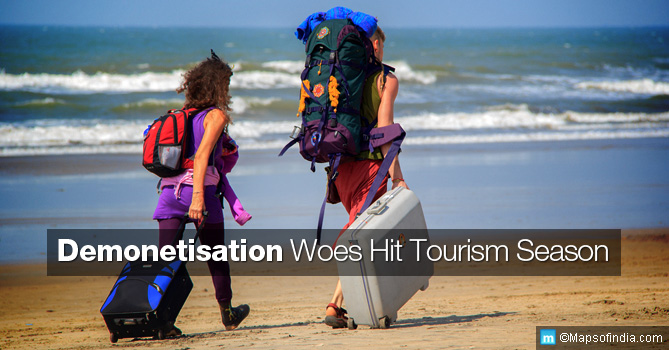On 8 November, 2016, Prime Minister Narendra Modi shocked the country by withdrawing high denomination notes (INR 500 and INR 1000) as legal tenders. The move was made with an intention to unearth the black money stashed by tax evaders, drug cartels, traffickers and other illegal entities. New INR 500 and INR 2000 notes were introduced but the move has caused much pain to the common man and a number of sectors in the country have been affected by the failure to replace the old currencies in adequate measure. It seemed obvious that real estate and retail business would be affected in the short term. The fallout of the demonetisation now looks to have spilled over into the tourism business as well.
Tourism Faces Demonetisation Brunt
In India, the peak tourism season lasts from October to January. While most of the domestic travellers visit Rajasthan, Maharashtra, Gujarat and Karnataka in October and November, hundreds of thousands of pilgrims visit shrines such as Sabarimala in December. The year-end party seekers look forward to a break in Goa and Maharashtra in late December and early January. Most of these tourist destinations have seen a drastic reduction in the bookings this year.
According to a recent study by the Associated Chambers of Commerce & Industry of India (Assocham), there has been a 65 percent drop in Christmas and New Year vacation bookings this year. Tourists who usually look to spend their vacation in Uttarakhand, Madhya Pradesh and Kerala have decided to stay back at home instead of taking their annual break. Following the travel advisory issued by most countries following the demonetisation, international travel to India has also dropped by 45 percent. November through January months witness the maximum inflow of international tourists to India. Cash crunch has adversely affected the liquidity of currency exchanges in the country leading to such a situation.
Goa Back On Its Feet
One of the most prominent tourist destinations for the year end period is Goa. Full of sandy beaches, towering churches and cathedrals, cafes and discos, this state has been a highly preferred destination on both domestic and international circuits. In fact, about 30 lakh tourists visit the state each year. After taking an initial hit following the demonetisation drive, Goa seems to be back on its feet in time for the New Year. A number of tourists had cut short their vacations in November following the announcement but the bookings for December and January seem to follow patterns of previous years.
The Path Ahead
The distress that has gripped the domestic travel industry is likely to be a short one. In fact, even Assocham’s study suggests that package deals have not been affected much. Only travellers and tourists who prefer to plan their own travel and keep a flexible itinerary have cancelled in the past few weeks. Flights and hotels have slashed their prices and are likely to spark a renewed interest now. Organised travel may now be preferred to do-it-yourself trips considering that they allow tourists to go cashless to a great extent. It may benefit local eateries, taxi operators and vendors to accept credit and debit cards and payments through mobile wallets. This will soon become necessary to stay in business.
Tips To Travel Cashless
- Plan in Advance – Not only can you book your train or airline tickets and hotel stay online but also make a number of other bookings well in advance and make payment through your debit or credit cards. Pick taxi operators and book tickets for shows and sightseeing attractions online. Download cab hailing apps such as Uber and Ola and link them with your card.
- Get Mobile Wallets – Mobile wallets are the latest craze in India post demonetisation. From the street side chaatwalas to grocery shops, just about everyone accepts some sort of mobile wallet payment. PayTM, Freecharge and MobiKwik are the most used mobile wallets in India.
- Use Social Media and Mobile Apps – Make use of the immense power of Social Media to locate a cash rich ATM when in need. The Walnut mobile application allows you to trace a functional ATM in the vicinity. Follow the #ATMswithCash hashtag for updates in your vicinity.
- Trust The Gods – We tend to blame all the problems of our country on religion. If you have run out of cash completely though, trust the local gurdwara or temple or masjid to come to your rescue and keep you well-fed till you lay your hands on some moolah.
Read more on Demonetization :
Two Months After Demonetisation – An Indian Economy Snapshot
After Note Ban Be Ready for ‘Benami’ Axe
What will the RBI do with the old currency notes?
Can India really become cashless?
How to Convert Black Money into White





